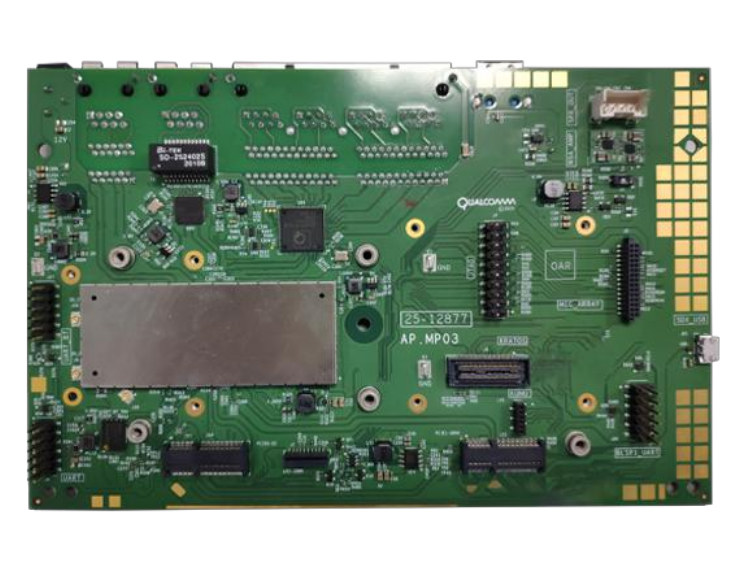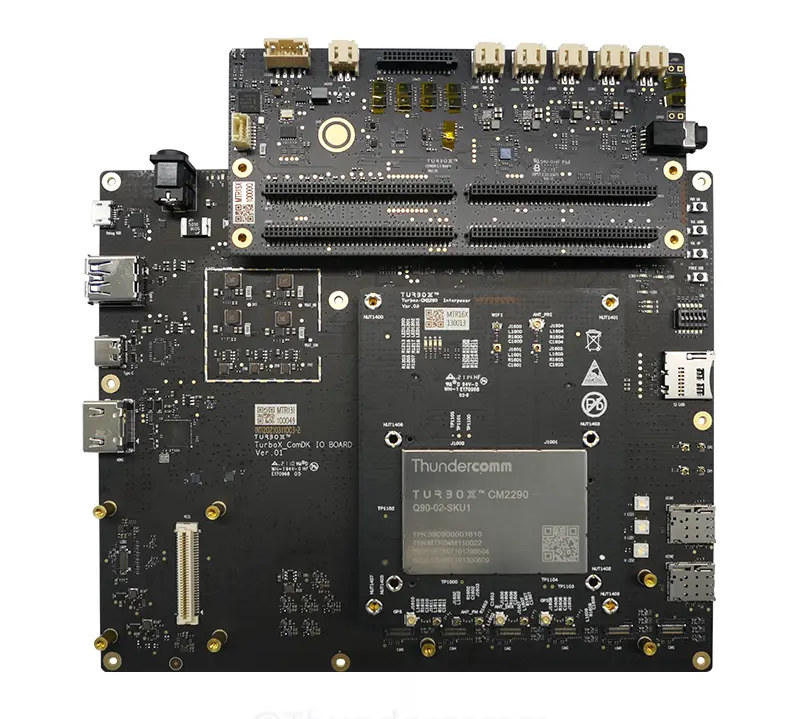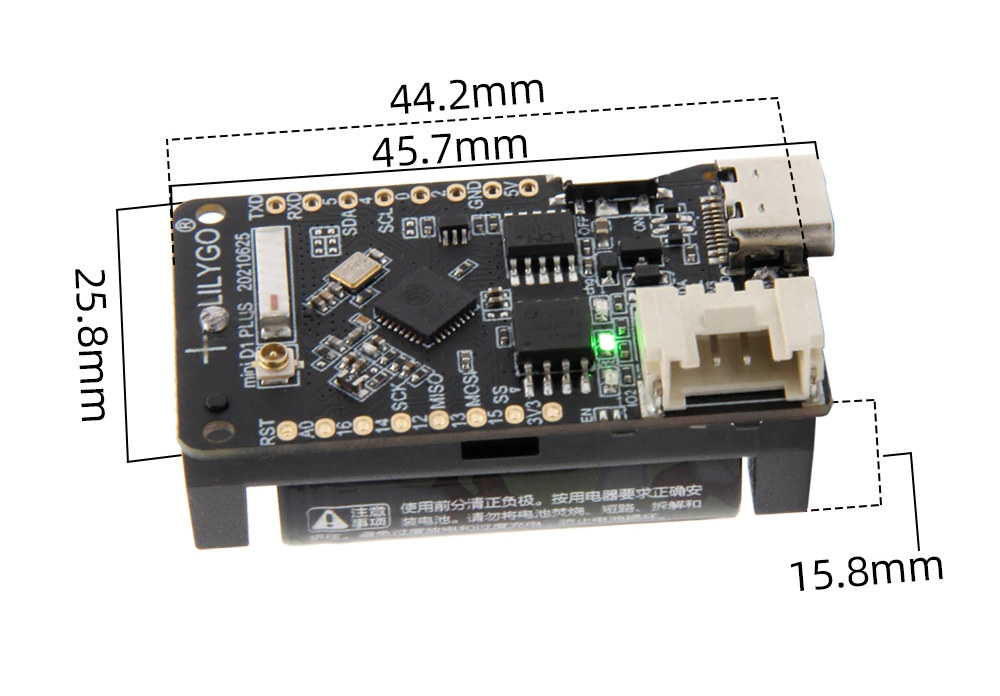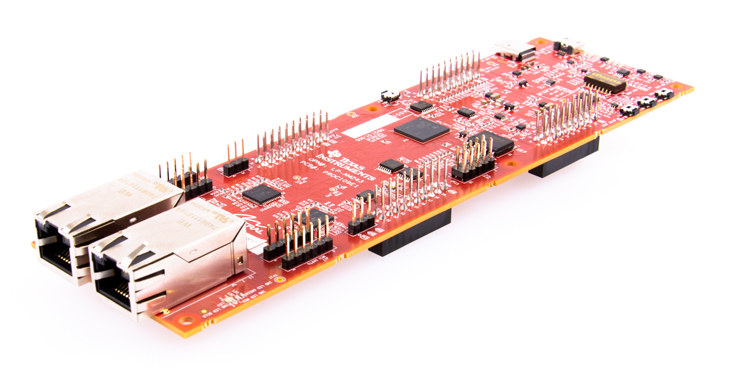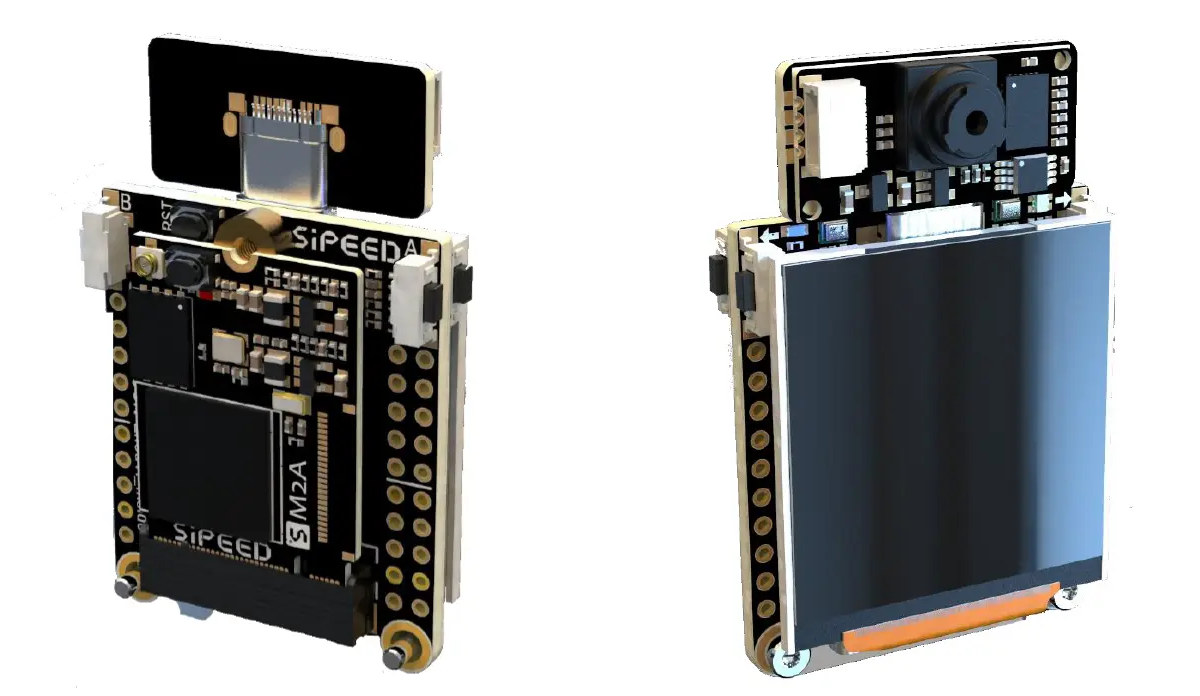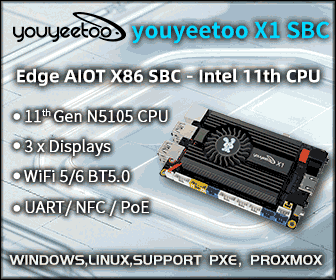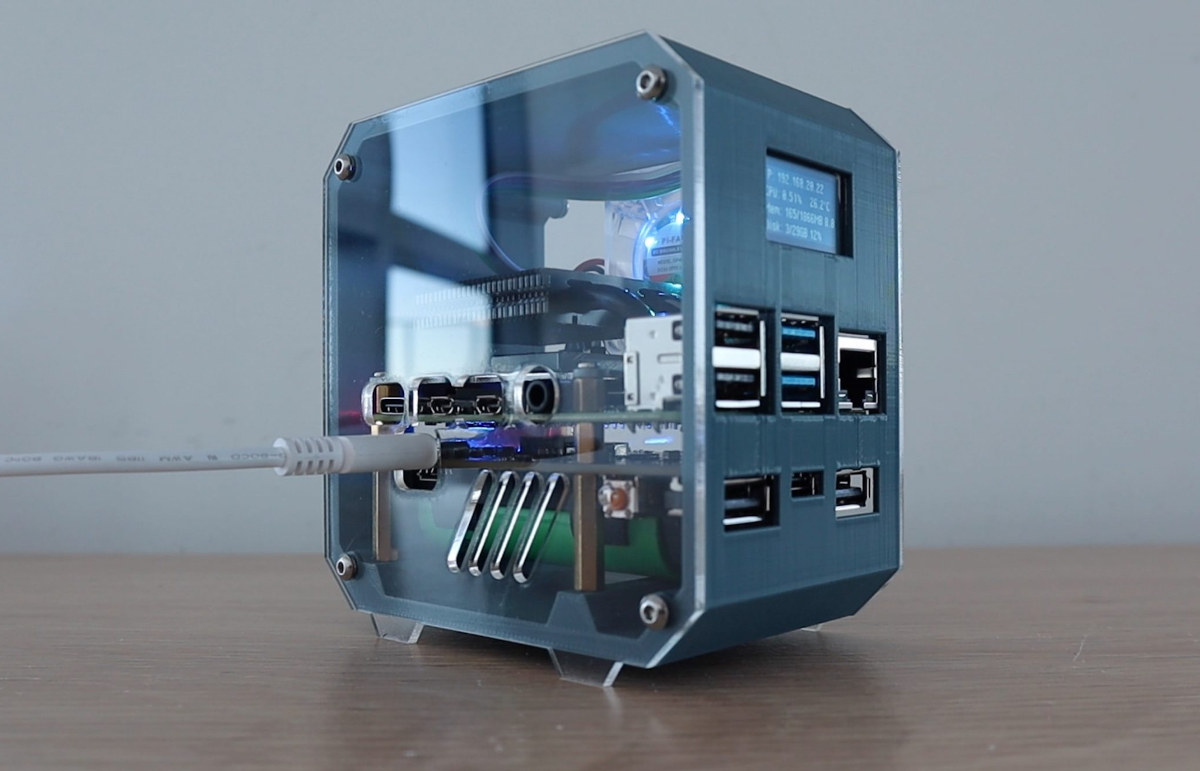Wallys Communication has been offering Qualcomm-based embedded router boards for several years, including the higher-end DR8072A with dual 2.5GbE and WiFi 6 connectivity, followed by a lower-cost WiFi 6 SBC based on IPQ6010 with Gigabit Ethernet ports. But if you’d like to benefit from the lower cost while keeping WiFi 6 and 2.5GbE, the company has now introduced a new model based on Qualcomm IPQ5018 dual-core Cortex-A53 SoC, also found in Xiaomi Mi AX6000 router, with DR5018 embedded router board. The blurry photo above reveals the board is also called AP.MP03, a name that looks like the typical name for Qualcomm reference designs. DR5018 specifications: SoC – Qualcomm Atheros IPQ5018 dual-core Arm Cortex-A53 processor @ 1.0 GHz System Memory – 512MB DDR3L Storage – 4GB or 8GB eMMC flash, 4MB Nor Flash, 128MB NAND flash Networking 4x Gigabit Ethernet Ports or 1x 2.5Gbps Ethernet port 1x Gigabit Ethernet Port On-board […]
Qualcomm QCM2290/QCS2290 SoM and Devkit target Industrial IoT applications
Last June, Qualcomm introduced several industrial IoT solutions that we did not cover at the time with Qualcomm QCM2290/QCS2290 IoT chip for camera applications, industrial handhelds, retail and tracking, Qualcomm QCS8250 WiFI 6 & 5G SoC for connected healthcare, digital signage, retail, and video collaboration, Qualcomm QCS6490/QCM6490 WiFI 6E & 5G SoC for connected healthcare, logistics management, retail, transportation, and warehousing, and Qualcomm QCS4290/ QCM4290 designed for cameras, industrial handhelds, and security panels with 4G LTE and WiFi 6 connectivity. Shortly after Qualcomm’s announcement, Thundercomm introduced the TurboX C2290/CM2290 system-on-module respectively based on Qualcomm’s quad-core Cortex-A53 QCS2290 SoC and QCM2290 SoC adding 4G connectivity. The module also offers WiF & Bluetooth, as well as MIPI display & camera interfaces, and the TurboX CM2290/C2290 development kit is also available to get started. TurboX CM2290 and C2290 SoM Specifications: SoC – Qualcomm Snapdragon QCM2290 or QCS2290 quad-core Cortex-A53 processor at up to […]
ESP32-C3 board comes with 16340 battery holder, D1 mini compatibility
It looks like ESP32-C3 floodgates have opened. We’ve just written about several NodeMCU ESP32-C3 boards, and now there’s another board with the RISC-V WiFI & Bluetooth processor. Meet LilyGo TTGO T-OI PLUS equipped with a 16340 battery holder. Getting a battery-powered ESP32-C3 board could prove to be very interesting as ESP32-C3 power consumption is much lower than ESP8266 and ESP32, notably in deep sleep mode, where the RISC-V processor consumes just 5uA, against 20 uA for ESP8266 and ESP32, and the difference is even greater in light sleep mode (ESP8266: 2000 uA vs ESP32-C3: 130 uA). LilyGo TTGO T-OI PLUS specifications: SoC – Espressif Systems ESP32-C3 single-core RISC-V processor @ 160 MHz with 2.4 GHz WiFi, Bluetooth 5.0 LE Storage – TBD flash (probably 2MB or 4MB) Antenna – Ceramic antenna and IPEX connector USB – USB-C port for power and programming Expansion 2x 8-pin headers with 12x GPIO, 1x […]
LP-AM243 dual Gigabit Ethernet MCU board features TI Sitara AM243x Cortex-R5F microcontroller
The few microcontroller boards that get Ethernet, are often limited to 10 Mbps or 100 Mbps, but the LP-AM243 LaunchPad development kit comes with two Gigabit Ethernet ports controlled by the newly announced 800 MHz Texas Instruments Sitara AM243x Cortex-R5F microcontroller with industrial communication and security features. TI Sitara AM243x Cortex-R5F microcontroller The Sitara AM243x is the first family of microcontrollers part of the larger Sitara AM2x MCU series that, a bit like NXP i.MX RT crossover processors, aims to combine the advantages of traditional microcontrollers and microprocessors by leveraging the real-time capabilities of the former and the high performance of the latter, but in a way optimized for industrial communication and safety. The Sitara AM243x family is comprised of three processors with one, two, or four cores with the following key features and specifications: CPU AM2431 – Single-core Cortex-R5F real-time core @ 800 MHz with 128KB TCM AM2432 – Dual-core […]
MAIX-II A AI camera board combines Allwinner R329 smart audio processor with USB-C camera
Earlier this year, we wrote about Sipeed MAIX-II Dock AIoT vision devkit with an Allwinner V831 camera processor with a small 200 MOPS NPU, an Omnivision SP2305 2MP camera sensor, and a 1.3-inch display. But for some reason, which could be supply issues, Sipeed has designed a much different variant called MAIX-II A with a board based on Allwinner R329 smart audio processor, a 720p30 USB camera module, and a 1.5-inch display. MAIX-II A board specifications: Main M.2 module – Maix-II A module with Allwinner R329 dual-core Cortex-A53 processor @ 1.5 GHz, 256MB DDR3 on-chip, a dual-core HIFI4 DSP @ 400 MHz, and Arm China AIPU AI accelerator for up to 256 MOPS, plus Wi-Fi & BLE and a footprint for an SPI Flash. Storage – MicroSD card socket Display – 1.5-inch LCD display with 240×240 resolution Audio – Dual microphones, 3W speakers Camera – 720p USB-C camera module based […]
XUAN-Bike self-balancing, self-riding bicycle relies on flywheel, 22 TOPS Huawei Ascend A310 AI processor
After Huawei engineer Peng Zhihui Jun fell off this bicycle, he decided he should create a self-balancing, self-riding bicycle, and ultimately this gave birth to the XUAN-Bike, with XUAN standing for eXtremely, Unnatural Auto-Navigation, and also happening to be an old Chinese name for cars. The bicycle relies on a flywheel and a control board with ESP32 and MPU6050 IMU for stabilization connected over a CAN bus to the motors, as well as Atlas 200 DK AI Developer Kit equipped with the 22 TOPS Huawei Ascend A310 AI processor consuming under 8W connected to a 3D depth camera and motor for self-riding. It’s not the first time we see this type of bicycle or even motorcycle, but the XUAN-Bike design is also fairly well-documented with the hardware design (electronics + 3D Fusion360 CAD files) and some documentation in Chinese uploaded to Github. The software part has not been released so […]
DIY Raspberry Pi 4 mini server includes UPS and OLED information display
While the Raspberry Pi 4 SBC has greater multimedia capabilities, it can also be used for headless projects like mini servers or networked access storage (NAS). Michael Klements’ DIY Raspberry Pi 4 mini server is especially interesting as it’s cute, and includes a UPS to handle power failures, plus an OLED display to show information. Here’s the final result. Ideally, you’d need a laser cutter and a 3D printer like the Ender 3 Pro to make the case, but most of the parts are off-the-shelf components including: A Raspberry Pi 4 SBC together with a 32GB MicroSD card for the operating system 52Pi/GeeekPi UPS Plus module (about $25) plus one or two 18650 Lithium-Ion Cells A Low Profile Ice Tower for cooling, but you could probably switch to your own (passive) cooling solution and make the device slightly more compact A 128×64 I2C OLED Display A 5V/3A Power Supply Accessories […]
Station M2 business-card sized Android 11 mini PC, also supports Ubuntu & Buildroot
After introducing Station P2 Rockchip RK3568 mini PC in March of this year, Firefly has now launched another, cheaper model with the ultra-thin Station M2 computer based on the company’s ROC-RK3566-PC single board computer equipped with Rockchip RK3566 SoC. Station M2 is only slightly larger than a business card, but packs up to 8GB RAM, M.2 SSD storage, HDMI 2.0, Gigabit Ethernet, and USB 3.0/2.0 ports. Station M2 specifications: SoC – Rockchip RK3566 with a quad-core Cortex-A55 processor @ up to 1.8GHz. Arm Mali-G52 2EE GPU with support for OpenGL ES 1.1/2.0/3.2. OpenCL 2.0. Vulkan 1.1, 0.8 TOPS AI accelerator, 4K H.265/H.265/VP9 video decoder, 1080p100 H.265/H.264 video encoder. System Memory – 2GB or 4GB LPDDR4 (8GB optional) Storage – 32GB or 64GB (128GB eMMC optional), M.2 PCIe 2.0 socket for 2242 NVMe SSD, MicroSD card socket Video Output – 1x HDMI port up to 4Kp60 Audio – 3.5mm headphone jack, […]


